
Journal of Animal Research: v.10 n.1, p. 137-141. February 2020

DOI: 10.30954/2277-940X.01.2020.20
Influence of Alteration of Dry Period Feeding Management on Body Weight and Body Measurements of Jersey Crossbred Cows at Lower Gangetic Region
ABSTRACT
Alteration during far off dry period feeding management was done to see its effect on body weight and body measurements of Jersey cross bred cows. This study was conducted on 14 healthy dairy animals which were separated into two comparable groups on the basis of almost similar age groups, parity, body weight, and body condition score. Statistically analyzed data revealed that there was significantly higher (p˂0.01) tail head thickness in overall dry period and at calving in control group animals than treatment group animals. Significantly higher (p˂0.01) overall abdominal girth after 4 months of lactation was found in control group animals as compared to treatment group animals. Significantly higher (p˂0.01) body length during overall dry period and at calving was noticed in control group animals. Non significant (p˃0.05) difference was reported in body weight and heart girth among control and treatment group animals. The coefficients of correlation indicated high and significant (P˂0.01) correlation among body condition score, tail head thickness, body length, heart girth, abdominal girth in this study. It can be concluded that alteration of feeding management practices during far-off dry period does not significantly change body weight during dry period and post partum period but can lead to significant difference in some body measurements of Jersey crossbred cows at tropical lower Gangetic region. Correlation of parameters suggested that the larger body sized animal of same breed may produce more milk.
Keywords: Body weight, Body measurements, Far off dry period, Jersey cross bred cows, Management
Importance of measuring body measurements and body weight has been remarked by many researchers (Bayram et al., 2006). More body loss and body condition loss leading to negative energy balance post partum are known to reveal adverse effects in high milk yielders (Friggens et al., 2007; Cutullic et al., 2010). During dry period, it is quite common trend that a dairy cow loses her body weight and body condition as she approaches to parturition (Roche et al., 2009). Slight loss of body weight during 30 days postpartum is commonly seen in high-yielders (Doepel et al., 2002). Relationship between body weight, body measurements and total milk yield has been found inconsistent by other research workers (Moore et al.,1991; Bayram et al., 2006).
Therefore the present study aims to study the influence of alteration of dry period feeding management of body weight and body measurements of Jersey cross bred cows. In addition to this, correlation of parameters like body weight, body measurements and total milk yield have also been studied.
MATERIALS AND METHODS
The present study was carried out at organized dairy farm at Eastern Regional Station, ICAR-National Dairy Research Institute (ERS-NDRI), cattle yard located in Kalyani, WB (lower Gangetic region of tropics). The latitude and longitude position being 22°56’30“N and 88°32’04“E, respectively.
How to cite this article: Singh, A.K., Bhakat, C., Kumari, T., Mandal, D.K., Chatterjee, A. and Dutta, T.K. (2020). Influence of alteration of dry period feeding management on body weight and body measurements of Jersey crossbred cows at lower Gangetic region. J. Anim. Res., 10(1): 137141.
Experimental animals
This experimentation was conducted during the year 2018 to 2019 on fourteen Jersey crossbred cow having almost similar age groups, body weight, BCS and parity. After an adaptation period the final observation was taken during whole dry period (60 days pre calving), continued during calving and post-partum up to 120 days of lactation period. Based on BCS, parity and body weight during drying off time (after completion of full lactation) animals were divided into 2 comparable groups i.e. group-1 as treatment and group-2 as control. However animals were free from all kind of physiological, anatomical and infectious disorders. Housing and other managements were similar to both groups.
Feeding alteration during dry period
Each dry cow of treatment group was provided with 33% less amount of concentrates (2 kg/day /animal) during far-off period (1 to 45 days) as compared to each dry cows of control group which received 3 kg /day /animal of concentrates during that same period. Both groups during close up (to calving) period (46 to 60 days) and postpartum period received concentrates as per the standard farm management practices. Ad libitum green and dry fodders were provided to both groups during dry period as well as postpartum period as per the standard farm management practices (NRC standards). Thus cows of treatment group consumed high fiber low energy diet than control group’s cows during far off dry period. Each cow of both group received same quality concentrate of BIS II type concentrate mixture (BIS, 2009).
Body weight
Each and every animal were stall fed in individual manger with separate watering provision. Body weight of each animals were measured early in the morning between 8.30 A.M to 9.30 A.M after completing morning milking and before providing any feed or water, using an electronic weighing scale with a precision of 200 g.
Body measurements
Following body measurements were taken on every fortnight measured early in the morning between 8.30 A.M to 9.30 A.M after completing morning milking and before providing any feed or water, using a measuring tape and measuring stand.
Heart girth (HG): Heart girth measurements were taken as the circumference of the thorax just behind the point of elbow.
Abdominal girth (AG): The circumference over the abdomen just behind the posterior border of the last rib and in front of the umbilicus.
Tail head thickness (THT): THT was taken as the thickness of the tail near the point of its attachment with the vertebral column.
Body Length
Body length was measured from point of shoulder to point-of-rump or pin bone.
Statistical Analysis: All data were meticulously analyzed by IBM SPSS statistics 21 software for statistical analysis. Each and every parameters was analysed by using the univariate General Linear Model (GLM) method for analysis of variance. The correlation coefficients were determined as per Pearson’s correlation method. The significant differences were set at P ˂ 0.05 and P ˂ 0.01.
RESULTS AND DISCUSSION
Body weight of dairy cows and calves
Mean body weight change in both the groups is shown in table (1). Body weights at calving or gain pre calving was found non significant between both groups. In both groups there was a decreasing trend of body weight till the 3rdmonth after calving as reported already by other workers (Contreras et al., 2004; Bernabucci et al., 2005), however, body weight changes of animals of both groups after calving was non significant of this study as depicted in fig. 1. Similar to the finding of this study, (Ryan et al., 2003) also found non significant difference in body weights of animals of different groups fed with different type of ration during dry period. Similar average body weight of calves was noticed in both groups. In this study, Average body weight of calves of treatment group animals was 25.07 kg while it was 25.21 kg in control group animal’s calves. Findings of this study are in line with results investigated by Ryan et al. (2003). BCS with BW were found to be corroborated with 0.53, 0.34, and 0.57 in some Jersey, Friesian and their respective crosses (Otto et al., 1991).
Table 1: LSQ mean ± S.E of body weight (kg) in Jersey crossbred cows
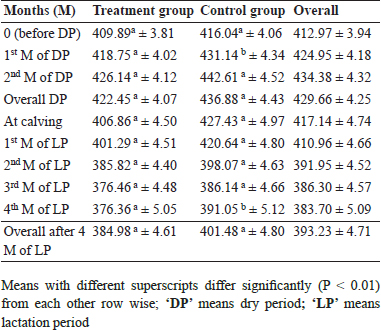
Body measurements
Body measurements in terms of heart girth (HG), abdominal girth (AG), body length (BL), tail head thickness (THT) were measured which are shown in their respected tables.
Heart girth (cm)
Table (2) shows patterns of mean heart girth changes during dry period, at calving, and post calving. It was reported that in both treatment and control group there was no significant change in heart girth during dry period, at calving, and post calving. However, HG of control and treatment groups was statistically non-significant, but comparatively more in control group animals. Hence, high HG was observed in more BCS animals and low HG in animals with low BCS. Similar result was investigated by (Gallo et al., 2001; Otto et al., 1991; Prasad, 1994) who had noticed strong correlation between HG and BCS.
Table 2: LSQ mean ± S.E of heart girth (cm) in Jersey crossbred
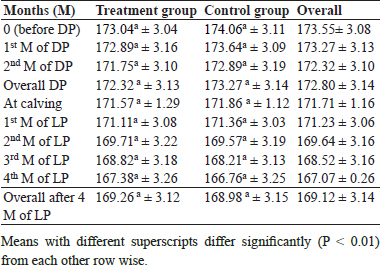
Abdominal girth (cm)
Mean abdominal girth of animals during pre- calving, at calving and post calving abdominal girth in both groups of both treatment and control group are shown in table (3). During pre calving and at calving period there was non significant difference among both the groups. However, a significant difference (p˂0.01) was noticed after 4 months of lactation in both group animals. AG was found significantly higher (p˂0.01) in control group animals. It is evident that higher BCS animals during lactation period had more AG. Present findings are in line with (Prasad, 1994) who found that there was correlation between AG and BCS.
Table 3: LSQ mean ± S.E of abdominal girth (cm) in Jersey crossbred cows
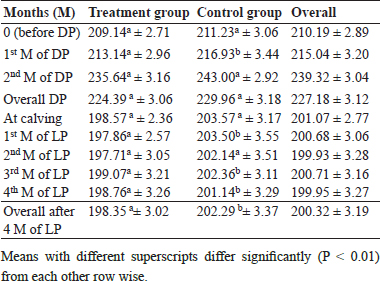
Body length (cm)
Table (4) depicts mean body length of animals during pre calving, at calving, and post calving period. Mean body length of animals of treatment group was significantly higher (p˂0.01) as compared to those in control group during dry period, at calving and during 4 months of lactation. Control group animals had slightly higher increased body length. This may be due to the more fat deposition and storage in body tissues. Similar findings were reported by (Bayram et al., 2006) who found positive significant (p˂0.05) correlation of body length with milk yield however, in this study positive correlation was seen at high significance level (p˂0.01).
Table 4: LSQ mean ± S.E of tail head thickness (cm) in Jersey crossbred cows
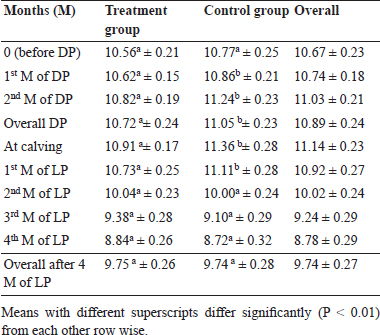
Tail head thickness (cm)
As shown in table (5) initially similar THT was seen in both group animals. Significantly higher (p˂0.01) THT was seen in overall DP and at calving for control group animals. This may be due to more subcutaneous fat deposition in control group animals than treatment group animals during dry period and at calving due to consumption of more energy diet by control group animals as compared to treatment group animals. However, non significant difference was seen in THT of both the groups during overall lactation period.
Table 5: LSQ mean ± S.E of body length (cm) in Jersey crossbred cows
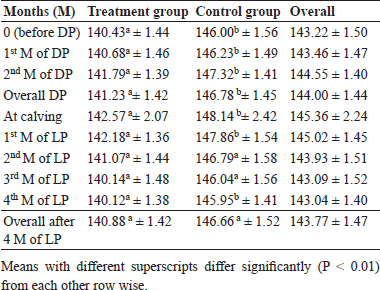
Correlation coefficients suggest that there was highly significant (p˂0.01) correlation between BCS, body weight and body measurements as shown in table (6).
Table 6: Correlation between different parameters of this study
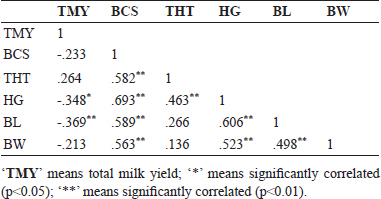
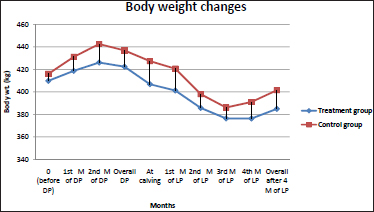
Fig. 1: LSQ mean ± S.E of body weight (kg) in Jersey crossbred cows
CONCLUSION
It can be concluded that alteration of feeding management practices during dry period does not significantly change body weight during dry period as well as post partum period but can lead to significant difference in some body measurements of Jersey crossbred cows at tropical lower Gangetic region. Furthermore, this study accomplishes and supports that larger body sized animals within same breed may produce more milk. This study also supports the fact that BCS is highly and positively correlated with body weight and body measurements of Jersey cross bred cows.
Acknowledgements
Authors have sincere gratitude to the Director, ICAR- National Dairy Research Institute, Karnal and Head, ERS, Kalyani for providing all facilities for this study and all who helped in direct / indirect ways.
REFERENCES
Bayram, B., Guler, O., Yanar, M. and Akbulut, O. 2006. Relationships among Body Weight, Body Measurements and Estimated Feed Efficiency Characteristics in Holstein Friesian Cows. J. Tekirdag Agric. Fac., 3 (1).
Bernabucci, U., Ronchi, B., Lacetera, N. and Nardone, A. 2005. Influence of body condition score on relationships between metabolic status and oxidative stress in periparturient dairy cows. J. Dairy Sci., 88 : 2017-2026.
BIS specifications for cattle feed. 2009. Archieved from http:// www. bis.org.in/qazwsx/cmd/CMD-II(Leg)_22092014.pdf
Contreras, L.L., Ryan, C.M. and Overton. T.R. 2004. Effects of dry cow grouping strategy and prepartum body condition score on performance and health of transition dairy cows. J. Dairy Sci., 87 : 517-523.
Cutullic, E. 2010. Competition between lactation and reproduction in the dairy cow. Ph.D thesis, Caen BasseNormandie University, France.
Doepel, L., Lapierre, H. and Kennelly, J.J. 2002. Peripartum Performance and Metabolism of Dairy Cows in Response to Prepartum Energy and Protein Intake. J. Dairy Sci., 85 (9): 2315-2334.
Friggens, N.C. and Badsberg, J.H. 2007. The effect of breed and parity on curves of body condition during lactation estimated using a non-linear function. Animal, 1 : 565-574.
Gallo, L., Carnier, P, Cassandro, M., Dal Zotto, R. and Bittante, G. 2001. Test-Day Genetic Analysis of Condition Score and Heart Girth in Holstein Friesian Cows. J. Dairy Sci., 84 (10): 2321-2326.
Moore, R.K., Kennedy, B.W., Schaeffer, L.R. and Moxley, J.E. 1991. Relationships between age and body weight at calving and production in first lactation Ayrshire and Holstein. J. Dairy Sci., 74 : 269-278.
Otto, K.L., Ferguson, J.D., Fox, D.G. and Sniffen. C.J. 1991. Relationship between body condition score and composition of ninth to eleventh rib tissue in Holstein dairy cows. J. Dairy Sci., 74 : 852.
Prasad, S. 1994. Studies on body condition scoring and feeding management in relation to production performance of crossbred dairy cattle. Ph.D. thesis, NDRI Deemed University, Karnal, India.
Ryan, G., Murphy, J., Crosse, S. and Rath, M. 2003. The effect of pre-calving diet on post-calving cow performance. Livest. Prod. Sci., 79 (1): 61-71.
Roche, J.R., Friggens, N.C., Kay, J.K., Fisher, M.W., Stafford, K.J. and Berry, D.P. 2009. Invited review: Body condition score and its association with dairy cow productivity, health, and welfare. J. Dairy Sci., 92 (12): 5769-5801.